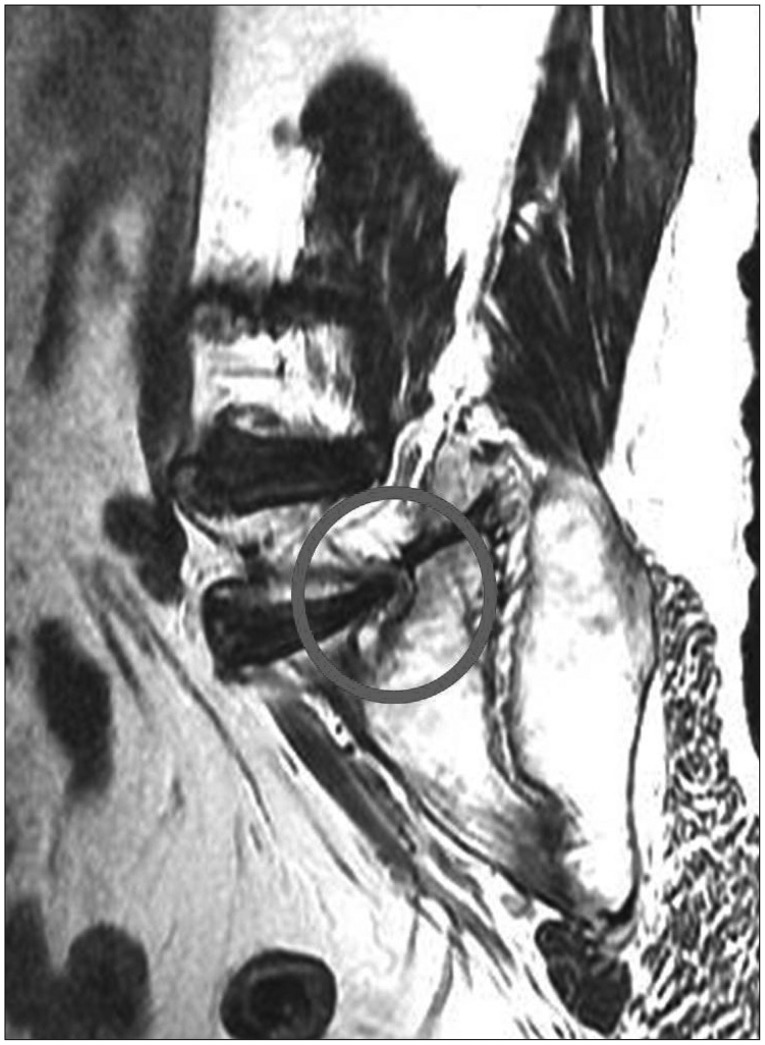J Korean Neurosurg Soc.
2016 Mar;59(2):143-148. 10.3340/jkns.2016.59.2.143.
Postoperative Clinical Outcome and Risk Factors for Poor Outcome of Foraminal and Extraforaminal Lumbar Disc Herniation
- Affiliations
-
- 1Department of Neurosurgery, Nanoori Hospital, Seoul, Korea. medmaxx@naver.com
- 2Department of Radiology, Nanoori Hospital, Seoul, Korea.
- KMID: 2192044
- DOI: http://doi.org/10.3340/jkns.2016.59.2.143
Abstract
OBJECTIVE
We evaluated postoperative outcomes in patients who have lumbar foraminal or extraforaminal disc herniation (FELDH) and suggested the risk factors for poor outcomes.
METHODS
A total of 234 patients were selected for this study. Pre- and post-operative Visual Analogue Scale (VAS) and Korean version Oswestry Disability Index (KODI) were evaluated and the changes of both score were calculated. Outcome was defined as excellent, good, fair, and poor based on Mcnab classification. The percentage of superior facetectomy was calculated by using the Maro-view 5.4 Picture Archiving Communication System (PACS).
RESULTS
Paramedian lumbar discectomy was performed in 180 patients and combined lumbar discectomy was performed in 54 patients. Paramedian lumbar discectomy group showed better outcome compared with combined discectomy group. p value of VAS change was 0.009 and KODI was 0.013. The average percentage of superior facetectomy was 33% (range, 0-79%) and it showed negative correlation with VAS and KODI changes (Pearson coefficient : -0.446 and -0.498, respectively). Excellent or good outcome cases (Group I) were 136 (58.1%) and fair or poor outcome cases (Group II) were 98 (41.9%). The percentage of superior facetectomy was 26.5% at Group I and 42.5% at Group II. There was significant difference in superior facetectomy percentage between Group I and II (p=0.000).
CONCLUSION
This study demonstrated that paramedian lumbar discectomy with preservation of facet joints is an effective and good procedure for FELDH. At least 60% of facet should be preserved for excellent or good outcomes.
Figure
Cited by 1 articles
-
Microsurgical Foraminotomy via Wiltse Paraspinal Approach for Foraminal or Extraforaminal Stenosis at L5-S1 Level : Risk Factor Analysis for Poor Outcome
Sung-Ik Cho, Chung-Kee Chough, Shu-Chung Choi, Jin-Young Chun
J Korean Neurosurg Soc. 2016;59(6):610-614. doi: 10.3340/jkns.2016.59.6.610.
Reference
-
1. Abdullah AF, Ditto EW 3rd, Byrd EB, Williams R. Extreme-lateral lumbar disc herniations. Clinical syndrome and special problems of diagnosis. J Neurosurg. 1974; 41:229–234. PMID: 4841878.2. Abdullah AF, Wolber PG, Warfield JR, Gunadi IK. Surgical management of extreme lateral lumbar disc herniations : review of 138 cases. Neurosurgery. 1988; 22:648–653. PMID: 3374776.
Article3. Baba H, Uchida K, Maezawa Y, Furusawa N, Okumura Y, Imura S. Microsurgical nerve root canal widening without fusion for lumbosacral intervertebral foraminal stenosis : technical notes and early results. Spinal Cord. 1996; 34:644–650. PMID: 8918959.
Article4. Chang SB, Lee SH, Ahn Y, Kim JM. Risk factor for unsatisfactory outcome after lumbar foraminal and far lateral microdecompression. Spine (Phila Pa 1976). 2006; 31:1163–1167. PMID: 16648754.
Article5. Cheng TM, Link MJ, Onofrio BM. Pneumatic nerve root compression : epidural gas in association with lateral disc herniation. Report of two cases. J Neurosurg. 1994; 81:453–458. PMID: 8057154.
Article6. Donaldson WF 3rd, Star MJ, Thorne RP. Surgical treatment for the far lateral herniated lumbar disc. Spine (Phila Pa 1976). 1993; 18:1263–1267. PMID: 8211356.
Article7. Epstein NE, Epstein JA, Carras R, Hyman RA. Far lateral lumbar disc herniations and associated structural abnormalities. An evaluation in 60 patients of the comparative value of CT, MRI, and myelo-CT in diagnosis and management. Spine (Phila Pa 1976). 1990; 15:534–539. PMID: 2402692.
Article8. Epstein NE, Epstein JA, Carras R, Hyman RA, Murthy Vish-Nubakat S. Far lateral lumbar disc herniation : diagnosis and surgical management. Neuroorthopedics. 1986; 1:37–44.9. Jenis LG, An HS, Gordin R. Foraminal stenosis of the lumbar spine : a review of 65 surgical cases. Am J Orthop (Belle Mead NJ). 2001; 30:205–211. PMID: 11300129.10. Kim DY, Lee SH, Lee HY, Lee HJ, Chang SB, Chung SK, et al. Validation of the Korean version of the oswestry disability index. Spine (Phila Pa 1976). 2005; 30:E123–E127. PMID: 15738775.
Article11. Kwon YJ. Minimally invasive combined interlaminar and paraisthmic approach for symptomatic lumbar foraminal stenosis : surgical technique and preliminary results. J Korean Neurosurg Soc. 2007; 42:11–15.12. Macnab I. Negative disc exploration. An analysis of the causes of nerve-root involvement in sixty-eight patients. J Bone Joint Surg Am. 1971; 53:891–903. PMID: 4326746.13. Marquardt G, Bruder M, Theuss S, Setzer M, Seifert V. Ultra-long-term outcome of surgically treated far-lateral, extraforaminal lumbar disc herniations : a single-center series. Eur Spine J. 2012; 21:660–665. PMID: 22179754.
Article14. McCulloch JA. Essentials of spinal microsurgery. Philadelphia: Lippincott-Raven Publishers;1998. p. 395.15. Novetsky GJ, Berlin L, Epstein AJ, Lobo N, Miller SH. The extraforaminal herniated disk : detection by computed tomography. AJNR Am J Neuroradiol. 1982; 3:653–655. PMID: 6816042.16. Porchet F, Chollet-Bornand A, de Tribolet N. Long-term follow up of patients surgically treated by the far-lateral approach for foraminal and extraforaminal lumbar disc herniations. J Neurosurg. 1999; 90(1 Suppl):59–66. PMID: 10413127.
Article17. Postacchini F, Montanaro A. Extreme lateral herniations of lumbar disks. Clin Orthop Relat Res. 1979; 138:222–227. PMID: 445902.18. Ryang YM, Rohde I, Ince A, Oertel MF, Gilsbach JM, Rohde V. Lateral transmuscular or combined interlaminar/paraisthmic approach to lateral lumbar disc herniation? A comparative clinical series of 48 patients. J Neurol Neurosurg Psychiatry. 2005; 76:971–976. PMID: 15965204.
Article19. Siebner HR, Faulhauer K. Frequency and specific surgical management of far lateral lumbar disc herniations. Acta Neurochir (Wien). 1990; 105:124–131. PMID: 2275423.
Article20. Viswanathan R, Swamy NK, Tobler WD, Greiner AL, Keller JT, Dunsker SB. Extraforaminal lumbar disc herniations : microsurgical anatomy and surgical approach. J Neurosurg. 2002; 96(2 Suppl):206–211. PMID: 12450284.
Article
- Full Text Links
- Actions
-
Cited
- CITED
-
- Close
- Share
- Similar articles
-
- Usefulness of Coronal MR Image in Diagnosis of Foraminal and Extraforaminal Disc Herniation
- Percutaneous Stenoscopic Lumbar Decompression with Paramedian Approach for Foraminal/Extraforaminal Lesions
- Microdecompression for Extraforaminal L5-S1 Disc Herniation; The Significance of Concomitant Foraminal Disc Herniation for Postoperative Leg Pain
- The Clinical Comparison between Open Surgery and Percutaneous Endoscopic Lumbar Discectomy in Extraforaminal Lumbar Disc Herniation
- Paramedian Tangential Approach for the Lumbosacral Extraforaminal Disc Herniations






